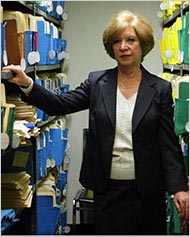


Penmark Property Advisors, LLC
NYTimes
The Downside for Condos in a Downturn
By TERI KARUSH ROGERS Published: February 6, 2009
DURING the recent boom, buyers who coveted condos for their sex appeal could also make the case that condos were a smarter choice than co-ops. WARNING SIGNS Adam D. Finkelstein, a real estate lawyer, says lien filings are rising.

But as the city’s fortunes buckle and heave, these very differences have potentially rendered some of the city’s condo buildings dangerously exposed to the downturn. Then there is a distinction many condo buyers probably dismissed as a boring legality: If a condo unit is the subject of a foreclosure, the bank gets first dibs on the equity. With real estate prices way off their peak, that means some condo buildings will collect nothing but dust from residents who have also failed to pay their common charges, leaving the remaining owners to shoulder the burden of higher costs or reduced services.
Defaults on common charges began to spike last fall, according to lawyers hired by increasingly jittery boards to file liens (the first step toward foreclosure) against owners in arrears
“We had maybe four or five before October,” said Adam Leitman Bailey, a Manhattan real estate lawyer, referring to the number of liens his firm filed last year against condo owners in Manhattan and Brooklyn. “It really got going this fall. We had 28 filings here and 17 in Brooklyn. These aren’t in the wealthiest or the poorest buildings. It’s the buildings with the younger 30- or 35-year-old professionals buying a $1 million to $2.5 million apartment, who haven’t been working for 20 or 30 years and are relying on their job to pay for it.” Other lien-filing lawyers said the pace had picked up by at least 10 to 25 percent.
“We’re seeing more, especially in the higher-end buildings where you never heard of foreclosures,” said Adam D. Finkelstein, a real estate lawyer with Kagan Lubic Lepper Lewis Gold & Colbert in Manhattan. Starting last quarter, his firm began filing two or three liens a month, up from two or three per year.
According to figures provided by the online research company PropertyShark.com, condo lien filings more than doubled in Brooklyn during the second half of 2008, and the number of filings in Manhattan zigzagged, with 156 in the first quarter, 186 in the second, 154 in the third and 203 in the fourth.
While the aggregate number of liens is still small (47 in Brooklyn and 67 in Manhattan in December, for example), they may be the first sign of trouble: Liens typically lag months behind defaults in common charge payments, and the bottom didn’t truly fall out of the city’s economy until last fall.
Moreover, barring a swift economic renaissance, lawyers, managing agents and condo boards are bracing for things to worsen significantly this year as job losses mount, severances and savings evaporate, and the new reality sets in. “The world as we’ve been living in it for the last several years has changed seemingly overnight,” Mr. Finkelstein said. “We’re at the very beginning of this.”
While lawyers are reporting a similar rash of defaults among co-op owners, the risk to the building (and by extension to the defaulter’s neighbors) is slight by comparison. That’s because a co-op building is entitled to its share before the bank can claim anything in the event of foreclosure (the ultimate consequence of nonpayment of maintenance charges).
But in condo foreclosures, the debt priorities are reversed. After a foreclosure process that these days can take two years — during which unpaid common charges proliferate — the building gets its due only after the bank is paid in full. And many condo owners have little equity in their apartments.
“I think it’s safe to say that the value of any apartment purchased in the last two years is less than its purchase price,” said David Kuperberg, the president of Cooper Square Realty, a Manhattan property management company. “The simple calculation is that if you bought an apartment a year ago and financed 90 percent of the purchase price, as many did, and now it’s worth 20 percent less, you’re upside-down as an owner.” Even worse from the perspective of the condo building, if an apartment owner defaults on common charges but keeps up with mortgage payments, it falls to the building rather than the bank to pursue the foreclosure action.
In that situation, the building must pay the bank the entire balance owed under the mortgage. This prospect is so onerous in a down market that a vast majority of liens for unpaid common charges never advance to the foreclosure stage, said Aaron Shmulewitz, a real estate lawyer at Belkin Burden Wenig & Goldman in Manhattan.
Instead, buildings often sue the owners personally — looking for other assets and garnishing wages, if there are any. But they are effectively powerless to force the expulsion of a deadbeat owner who has no equity. So far, there hasn’t been an uptick in condo foreclosure filings in Manhattan and Brooklyn, according to PropertyShark.com. Instead, owners in financial distress seem more willing to play chicken with the condo board than with the bank, and they appear to have some wiggle room when pressed.
Mr. Bailey said that to date, a majority of defaulting owners had paid up once his firm had filed a lien. “The owners are hoping we won’t file, and then they find a way to pay, whether they’re borrowing it from relatives or using their last dime,” said Mr. Bailey, who observed that the days of refinancing one’s way out of debt were long gone. “Usually they will pay for their home first, before credit cards and health insurance, because keeping a roof over their heads is their family’s biggest priority.”
But the biggest priority for condo buildings is preserving cash flow. With smaller reserves dictating a more hand-to-mouth lifestyle than that of most co-ops, many have little choice but to assess owners if defaults grow large enough. Never welcome, increased assessments can push additional owners over the brink and into arrears. That is one reason many managing agents and lawyers have begun encouraging condo boards to forsake neighborly empathy and play hardball.
“It used to be three months and then you’d file a lien, and now at the most it’s two months and in many case it’s just one month,” Mr. Shmulewitz said.
Just how long to wait depends on a building’s exposure. “If two people are defaulting in a 200-unit building,” Mr. Finkelstein said, “you can probably exercise some leniency. But it’s more problematic in a 40-unit building, even though it probably won’t kill you. You’ve got to evaluate your risk. If you know someone has a very low mortgage and there’s a lot of equity, you can cut them a little slack, because you can collect if there’s a foreclosure.”
While all condo buildings share vulnerabilities putting them at greater risk than co-ops to defaulting owners, condos of recent vintage appear to be in the greatest peril. For starters, these buildings often have less-experienced boards to navigate a crisis.
“The fear is much more acute in newer buildings than in established condominiums,” said Mr. Kuperberg, the managing agent, whose company has helped about 40 buildings open in the past three years. “There’s a greater likelihood that many apartments were sold for more than they’re worth today. And newer buildings have many people who bought with no-income-verification loans and very relaxed criteria. They also have younger owners who may be less established.”
What’s more, many of these overleveraged, less well established owners are among the several hundred thousand who bought under the 421-a tax abatement program. As the 10-year abatements phase out in steps every two years, the recipients experience increasingly drastic tax increases — which many had been counting on income gains to offset.
Consider the following hypothetical situation, provided by Paul J. Korngold, a real estate lawyer in Manhattan, which he said was consistent with many Manhattan units selling in the $1 million to $2 million range under the 421-a program. What starts out as a $1,214 annual tax bill climbs to $4,613 in the third year, $8,012 in the fifth year, $11,411 in the seventh year and $18,209 when the abatement expires.
But those numbers assume that the city doesn’t raise assessed values or tax rates. Factoring in what Mr. Korngold called a historically conservative 3 percent combined average increase, the unit owner who begins with a $1,214 annual tax bill owes $10,046 in the fifth year and a staggering $32,887 when the abatement expires.
Nearly 300,000 condo units were constructed under the program in the five boroughs from 2002 through 2007, according to the Department of Finance. That figure includes 132,431 units in Manhattan, where about 22,000 owners are in their fourth year of the program, 31,000 are in their fifth or sixth, and 12,000 are in their seventh. Because 421-a purchases were concentrated in a limited number of buildings, they are potentially destabilizing to these buildings in a down economy.
Mr. Kuperberg sketched out a second chain of events, this one pertaining to new buildings with many unsold units. It unfolds like this: Unable to sell half the units in a building, a struggling developer stops paying common charges and defaults on obligations to the lender. Foreclosure by the lender may take years, while individual unit owners effectively wind up paying double their normal common charges. This pushes some owners, themselves struggling, into default. Meanwhile, they are trapped — unable to sell, even at a steep loss, because most mortgage lenders won’t lend to potential buyers in a building where half the units are in default.
“That is a death spiral that could push a building into bankruptcy,” Mr. Kuperberg said. “You basically have a building unable to meet its operating expenses.”
Once the lender succeeds in foreclosing on the developer, there may not be enough money to cover the lender costs and unpaid common charges, forcing the unit owners to permanently swallow the loss. And while the lender must pay carrying costs going forward, it may decide not to throw good money after bad and instead dump the units at auction. The investors who buy them may act against the building’s best interests — renting them out cheaply (introducing a transient population that, among other things, inflicts more wear and tear) and electing boards who defer maintenance and refuse to make improvements.
“We work with a building that’s about 50 percent sold and the developer is gone — they lost all their money and they weren’t able to sell,” said one managing agent who asked to remain anonymous out of concern for the impact on property values in the building. “The lender took over and pays the common charges but doesn’t talk to us and won’t return our calls. If you’re running a building and 50 percent of the ownership doesn’t give you direction, that’s a problem. But I’m really nervous about what happens if the lender sells into the vulture market.” Even condo boards in fully sold buildings have begun to contemplate the once unthinkable: slashing the very amenities that defined the recent boom.
“The boards are starting to talk about cutting things that might be considered a little excessive,” said Leslie Bogen Winkler, the vice president and director of management at Penmark Realty, a property management firm that has opened 50 condo buildings in the last three and a half years. “They may reduce health-club hours and maybe scale back breakfast. The biggest amenities that are costly are the health club with a swimming pool. It can run up to $200,000 to $400,000, depending on the size, hours open and operator.” Staff cuts may also be in the offing at some buildings, though union contracts present significant hurdles. Moreover, said J. Brian Peters, the senior managing director of property management for Rose Associates, which owns or manages about 20,000 apartments in New York, “you can cut positions, but at a certain level that’s devaluing the product. And it’s the best product that’s going to survive the easiest in this downturn. We’re really more focused on increasing revenue.”
To that end, condo boards are considering adopting flip taxes, increasing alteration fees and bumping up sublet fees. They are also easing restrictions on the length of sublets so that strapped owners unable to sell their units can more easily rent them out.
Then again, other condos have the luxury of spare cash and might actually come out ahead in the downturn, Mr. Kuperberg said. “The recession can be a good opportunity to buy capital improvements and do upgrades,” he explained, “because contractors don’t have a lot of work and material costs are way down. It’s an opportunity to invest not only in cosmetic things like the lobby but in infrastructure that could reduce operating costs.”